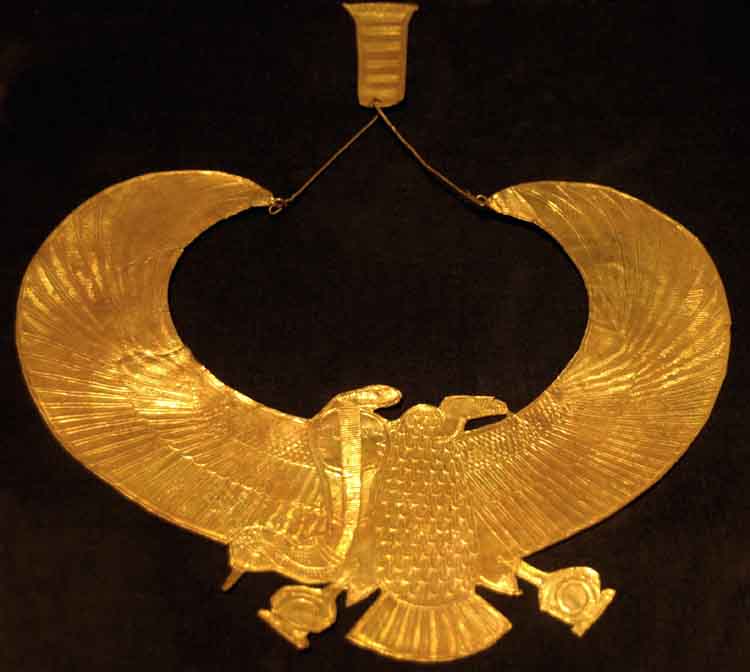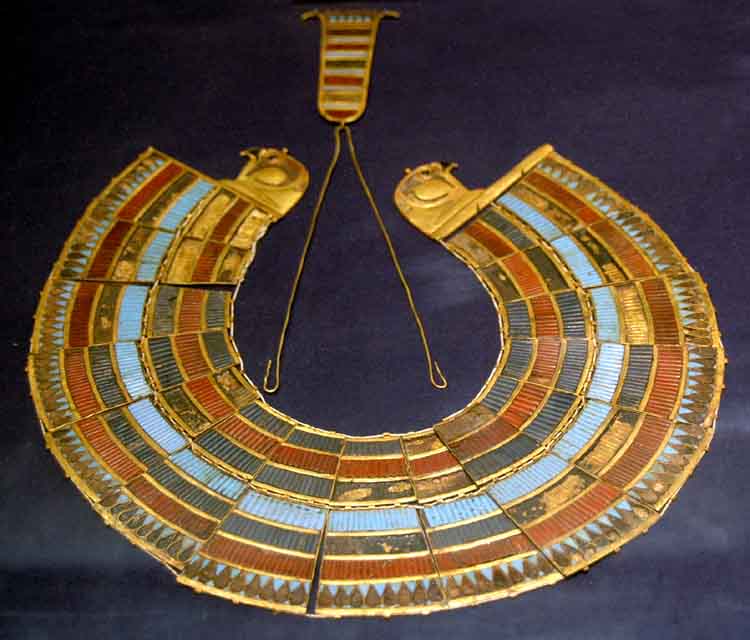- It was 'hanging' from the neck by a wire, and this had a mankhet at the back.
|
Tutankhamun's burial jewellery
The central element is a scarab made form a translucent green chalcedony. Attached to it are the open wings and tail of a vulture (Nekhebet) which are inlayed with coloured glass. The legs of the bird are grasping the shen hieroglyph which is the symbol of eternity. It is also holding a bunch of lotus flowers (right) and a lily (left), symbols of Upper (Southern) Egypt. Below the vulture's tail are garlands of lotus (Upper Egypt) and papyrus (Lower Egypt). Flanking the scarab are the profiles of two cobra, inlaid with coloured glass paste and bearing yellow solar discs on their heads. Resting on the vulture's wings is a thin boat with a Wedjat eye, the left eye of Horus representing the moon and flanked by two face-on cobra with solar discs on their heads. This boat represents the journey taken by the moon which in Egyptian mythology sailed across the sky each night. Above the boat is a silver lunar disc with a gold crescent. Three figures are shown on gold relief - the protagonists in a celestial coronation scene. In the centre the Pharaoh wearing a crown (with a moon above him) and flanked by two divinities making protective gestures - on the left is the ibis-headed moon god Thoth and on the right is the falcon-headed god Re-Horakhty. The pectoral is a combination of symbolism, mixing moon and sun as heavenly bodies associated with the power of the Egyptian Kings. |
 To
the left is a Flexible collar o To
the left is a Flexible collar o f Nekhebet (vulture)
with superb workmanship, made up of 256 gold plaques inlaid with polychrome
glass and threaded together with borders of tiny beads. f Nekhebet (vulture)
with superb workmanship, made up of 256 gold plaques inlaid with polychrome
glass and threaded together with borders of tiny beads.Tutankhamun's thorax (neck down to the abdomen) had 35 different objects. These objects were in seventeen groups, and in thirteen different layers of wrapping. The first of the layers was a series of gold collars extending below the clavicle and covering the shoulders. These collars were 'hanging' from the neck by a wire, and this had a mankhet at the back. Each collar was places to partially overlap each other. The top right was a collar with Nekhebet vulture. To the top left was a chased sheet gold amulet collar known as "the collar of Nebti", which combines the Buto and Nekhebet (see the picture to the right). The Buto is a winged serpent. The next, even further to then left was a collar representing the Buto alone, with it's wings outstretched. The last collar was to the right of the centre of his chest and was of the Hawk.
|

|
Tutankhamun's Death Mask and funerary goods. Cairo Museum, Egypt.
